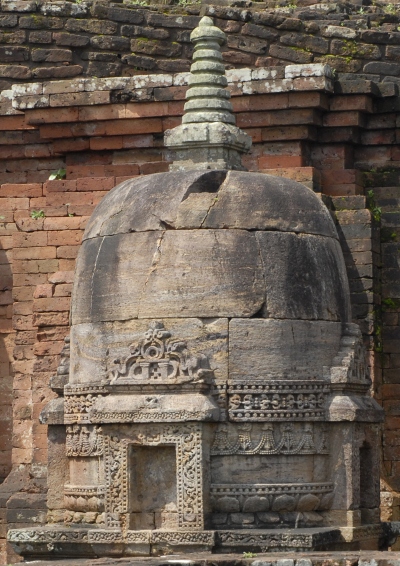 |
| A caitya in the form of a Kālacakra stupa, at Ratnagiri, Orissa. Click on the image for higher resolution. |
General description
of the
Kālacakra calendar
The Kālacakra calendar is a luni-solar calendar based on a 60-year cycle. Unlike the western calendar, the months last from new Moon to new Moon, and are defined by the sign of the zodiac the Sun enters during the month. Occasionally, the Sun does not change sign during a month, and this month is considered an extra, or intercalary, month (zla bshol, zla lhag pa). The extra month is considered in the Kālacakra tradition to have the same characteristics as the previous month, although the system followed in Tibetan calendars is that the intercalary has the same characteristics as the month that follows it.
As the point of entry into the zodiacal signs defines each month, then on average the sign is entered right in the middle of the month concerned, which means at the time of full Moon. The full Moon will only actually occur at that position rarely, but it does mean that there is an average position in the sky for each month's full Moon – the point exactly opposite the start of the sign defining the month.
This average point in the sky will lie either in a lunar mansion or at the border between two lunar mansions, and each month is named after either the lunar mansion that the point is within, or one of the two that it borders.
| Indian seasonal names for the months together with the sign the Sun enters during the month. The first column gives the names that are derived from the lunar mansion in which the full Moon approximately occurs, with Tibetan translations. | |||
| Caitra, nag pa | Mid-spring | Aries | |
| Vaiśākha, sa ga | Late-Spring | Taurus | |
| Jyeṣṭha, snron | Early-summer | Gemini | |
| Āṣāḍha, chu stod | Mid-summer | Cancer | |
| Śrāvaṇa, gro bzhin | Late-summer | Leo | |
| Bhādrapada, khrums | Early-autumn | Virgo | |
| Āśvina, tha skar | Mid-autumn | Libra | |
| Kārtikka, smin drug | Late-autumn | Scorpio | |
| Mārgaśīrṣa, mgo | Early-winter | Sagittarius | |
| Pauṣa, rgyal | Mid-winter | Capricorn | |
| Māgha, mchu | Late-winter | Aquarius | |
| Phālguna, dbo | Early-spring | Pisces | |
There are generally considered to be two reasons for the month Caitra starting the year: the Buddha is said to have taught the Kālacakra Tantra on the full Moon day of the month Caitra, in the year following his enlightenment, and, during the month Caitra the Sun enters Aries, the beginning of the zodiac. From this point of view, the vernal equinox, when the Sun is at the first point of Aries, is the true indicator of the beginning of a new year.
Five components of the calendar.
The days of each month are characterized according to five different factors or components (pañcāṅga, lnga bsdus, or, yan lag lnga). These are the weekdays (vāra, res gza'), lunar days (tithi, tshes pa), lunar mansions (nakṣatra, rgyu skar), yogas (sbyor ba) and karaṇas (byed pa).A solar day (dina, nyin zhag) is the normal day from mean daybreak to mean daybreak (nam langs), and these are given the names of the seven planets or weekdays: the Sun (Sunday), the Moon (Monday), Mars (Tuesday), Mercury (Wednesday), Jupiter (Thursday), Venus (Friday) and Saturn (Saturday). Strictly speaking the solar days (sometimes also called civil days) are given the name of one of the seven weekdays, although in many instances the terms solar day and weekday are interchangable. Either way, the days are of equal length, and an average first-light time is used as the start of each day, which equates in western terms to 5am Local Mean Solar Time.
Similarly to each solar day being given the attributes of one of the weekdays, so at the start of each solar day, one of the other four components of the calendar will be in force, and will be applied to the solar day.
The second component of the calendar is the lunar day. There are 30 lunar days in a month, but instead of dividing the period between new Moons into 30 parts by time, the division is by angular separation of the Sun and Moon. So, the first lunar day is the period of time between exact new Moon and the moment when the angle between the Sun and Moon is exactly 12°. The second lunar day extends from that moment to when the angle between the Sun and Moon is exactly 24°, and so on.
 |
Kalkī Aja, said to have reformed the Kālacakra calendar in 806 C.E. |
This is how the dates – it is convenient to call them "lunar dates" – of the calendar are derived. Because the length of the lunar days varies, it is sometimes the case that the same, slightly longer, lunar day is in effect at the beginning of two successive solar days. In this case that particular lunar date is duplicated (lhag pa) – it occurs on two days. Also, when the lunar day is a little short, it can happen that an entire lunar day elapses within a single solar day.
For example, if lunar day number 7 ends just after the start of a Wednesday, then that solar day will have the number 7. But if the lunar day number 8 is short, and ends before the end of the Wednesday, by the time the next solar day, the Thursday, starts, lunar day number 9 will be in effect. The Thursday will have the number 9, and the 8th lunar day will be omitted (chad pa).
The third component of the calendar is the position of the Moon at the beginning of the solar day in the group of 27 lunar mansions. Just as the zodiac of 12 signs divides the ecliptic into 12 equal parts, so the lunar mansions divide the ecliptic into 27 equal parts. Similarly to the zodiac, the lunar mansions start at the first point of Aries, and so the sign of Aries contains the first two lunar mansions (Aśvinī and Bharaṇī) and the first quarter of the third mansion, Kṛittikā.
Just as the normal 12 signs of the zodiac represent the approximate movement of the Sun in a month, so the 27 lunar mansions each represent the approximate movement of the Moon in a day.
Incidentally, the lunar mansions are used in the Kālacakra system as the means of describing longitude. For this purpose the mansions are numbered 0 (Aśvinī) to 26. They are also each subdivided into 60 nāḍī (chu tshod), each of which can be further subdivided into 60 pala (chu srang). Each of these units are further subdivided into six breaths. Further subdivisions are also used, but we can ignore these.
It is convenient to write such measurements as three or four figures separated by either semi-colons or commas. The semi-colon separates integers from fractions, and commas separate sexagesimal and other fractional places. This notation is commonly used in western representation of ancient Babylonian mathematics, where the use of base-60, or sexagesimal, arithmetic originated.
For example, 0;12,0 means zero (ie. in the first) mansions, 12 nāḍī and zero pala. This is equal to a longitude of 2° 40' from the first point of Aries. Also, the longitude given in the Vimalaprabhā for the solar position at the winter solstice is 20;15,0. This is a quarter of the way through the 21st lunar mansion, and is equivalent to 270° – the first point of Capricorn.
Strictly speaking, the Kālacakra sytem is not identical to the Babylonian one, which was entirely sexagesimal. In the Kālacakra fractions the first two places after the integer are always base 60, the next is usually base 6, and for any other places the radix depends upon context. However, these differences do not detract from the usefulness of using the same system as is used for representing Babylonian fractions.
The fourth component of the calendar, the yogas, also effectively depends on a division of the ecliptic into 27 parts, although that is not the way they are normally described. The yoga in force at the beginning of a solar day is determined by adding together the longitudes of the Sun and Moon. If this goes over a full circle, that circle is subtracted, and then the yoga is found by considering the full circle to be divided into 27 equal parts. The yogas are numbered 0 to 26, and it is as if we were determining the lunar mansion in which the compound longitude falls, although it not usually described in this way.
The final component of the calendar is the set of karaṇas. There are 11 of these and they are effectively equivalent to half a lunar day each. Four of the karaṇas occur only once in each lunar month, and there are seven that repeat in a cycle through the other days of the month. The karaṇas are simply halves of a lunar day – there are two to each lunar day, and they therefore represent the time between successive separations between the Sun and Moon in multiples of 6°.
The calendar published on this web site follows the description of the calendar as given in the original Kālacakra literature as closely as possible, but using modern calculation techniques. Click here for further details about the calendar published on this site. A selection of calculated calendars is available here and the software used to calculate those calendars, using modern astronomy, is to be found here. Software to calculate the calendar using traditional calculations is available here.
 |
E. Henning. Last updated 27 July 2013. Return to calendar introduction. |